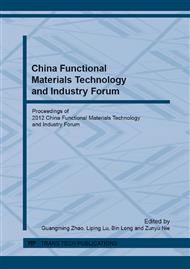[1]
Z. Yin, S. Wu, X. Zhou, X. Huang, Q. Zhang, F. Boey, and H. Zhang, Small Vo.6 (2010), P.307.
Google Scholar
[2]
C. E. Small, S. Chen, J. Subbiah, C. M. Amb, S. W. Tsang, T. H. Lai, J. R. Reynolds, and F. So, Nature Photonics Vol.6 (2012), p.115
Google Scholar
[3]
S. Bai, Z. Wu, X. Xu, Y. Jin, B. Sun, X. Guo, S. He, X. Wang, Z. Ye, and H. Wei, Applied Physics Letters Vol.100 (2012), P.203906.
Google Scholar
[4]
Y. Qin, X. Wang, and Z. L. Wang, Nature Vol.451 (2008) , P.809.
Google Scholar
[5]
G. Zhu, R. Yang, S. Wang, and Z. L. Wang, Nano Lett Vol.10 (2010), p.3151.
Google Scholar
[6]
G. Hirata, J. McKittrick, T. Cheeks, J. Siqueiros, J. Diaz, O. Contreras, and O. Lopez, Thin Solid Films Vol.288 (1996), p.29.
DOI: 10.1016/s0040-6090(96)08862-1
Google Scholar
[7]
R. G. Gordon, Mrs Bulletin Vol.25 (2000), P.52.
Google Scholar
[8]
T. Minami, Mrs Bulletin Vol.25 (2000), P. 38.
Google Scholar
[9]
P. Sharma, A. Gupta, K. Rao, F. J. Owens, R. Sharma, R. Ahuja, J. M. O. Guillen, B. Johansson, and G. Gehring, Nature materials Vol.2 (2003), P.673.
DOI: 10.1038/nmat984
Google Scholar
[10]
J. Coey, M. Venkatesan, and C. Fitzgerald, Nature materials Vol.4 (2005), P.173.
Google Scholar
[11]
A. Behan, A. Mokhtari, H. Blythe, D. Score, X. Xu, J. Neal, A. Fox, and G. Gehring, Physical review letters Vol.100 (2008), P.47206.
Google Scholar
[12]
V. M. Guérin, J. Rathousky, and T. Pauporté, Solar Energy Materials and Solar Cells Vol.12 (2011), p.8.
Google Scholar
[13]
Y. Gao, M. Nagai, T. C. Chang, and J. J. Shyue, Crystal Growth and Design Vol.7 (2007), P.2467.
Google Scholar
[14]
S. Haller, T. Suguira, D. Lincot, and T. Yoshida, physica status solidi (a) Vol.207 (2010), p.2252.
DOI: 10.1002/pssa.201090021
Google Scholar
[15]
O. Lupan, V. Guérin, I. Tiginyanu, V. Ursaki, L. Chow, H. Heinrich, and T. Pauporté, Journal of Photochemistry and Photobiology A: Chemistry Vol.211 (2010), p.65.
DOI: 10.1016/j.jphotochem.2010.02.004
Google Scholar
[16]
J. J. Wu, Y. R. Chen, W. P. Liao, C. T. Wu, and C. Y. Chen, ACS Nano Vol.4 (2010), p.5679.
Google Scholar
[17]
Z. He, C. Zhong, S. Su, M. Xu, H. Wu, and Y. Cao, Nat Photon Vol.6 (2012), p.593.
Google Scholar
[18]
B. Cao, Y. Li, G. Duan, and W. Cai, Crystal growth & design Vol.6 (2006), p.1091.
Google Scholar
[19]
C. L. Perkins, S. H. Lee, X. Li, S. E. Asher, and T. J. Coutts, Journal of Applied Physics Vol.97 (2005), p.034907.
Google Scholar
[20]
Ang Yu, Jieshu Qian, Hao Pan, Yuming Cui, Meigui Xu, Luo Tu, Qingli Chai, Xingfu Zhou, Sensors and Actuators B Vol.158 (2011), p.9.
Google Scholar
[21]
C.Jagadish and S. pearton: Zinc Oxide Bulk, Thin Films and Nanostrctures(Elsevier publication, UK and 2008).
Google Scholar
[22]
D. K. Hwang, H. S. Kim, J. H. Lim, J. Y. Oh, J. H. Yang, S. J. Park, K. K. Kim, D. Look, and Y. Park, Applied Physics Letters Vol.86 (2005), p.151917.
Google Scholar
[23]
C. H. Liu, J. A. Zapien, Y. Yao, X. Meng, C. S. Lee, S. Fan, Y. Lifshitz, and S. T. Lee, Advanced Materials Vol.15 (2003), p.838.
DOI: 10.1002/adma.200304430
Google Scholar
[24]
Z. Yin, S. Wu, X. Zhou, X. Huang, Q. Zhang, F. Boey, and H. Zhang, Small Vol.6 (2009), p.307.
Google Scholar
[25]
L. Li, Y. Zhang, P. Xiao, Y. Yang, L. Lu, and X. Zhang, in Nanoelectronics Conference (INEC), 2010 3rd International, IEEE(2010), p.1001.
Google Scholar
[26]
J. Wu and D. Xue, Science of Advanced Materials Vol.3 (2011), p.127.
Google Scholar
[27]
L. Li, S. Pan, X. Dou, Y. Zhu, X. Huang, Y. Yang, G. Li, and L. Zhang, The Journal of Physical Chemistry C Vol.111 (2007), p.7288.
Google Scholar
[28]
M. Wong, A. Berenov, X. Qi, M. Kappers, Z. Barber, B. Illy, Z. Lockman, M. Ryan, and J. MacManus-Driscoll, Nanotechnology Vol.14 (2003), p.968.
DOI: 10.1088/0957-4484/14/9/306
Google Scholar
[29]
M. Chen, X. Wang, Y. Yu, Z. Pei, X. Bai, C. Sun, R. Huang, and L. Wen, Applied Surface Science Vol.158 (2000), p.134.
Google Scholar
[30]
Y. Ryu, S. Zhu, J. Budai, H. R. Chandrasekhar, P. F. Miceli, and H. White, Journal of Applied Physics Vol.88 (2000), p.201.
Google Scholar


